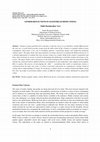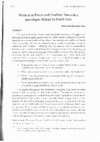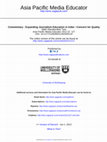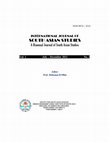Papers by Dr. Nidhi Shendurnikar

Journal of Communication and Management
The internet has become an essential and inseparable component of our daily life. This is particu... more The internet has become an essential and inseparable component of our daily life. This is particularly apparent in the way we currently consume, shop, and make purchases. India quickly and successfully adopted the concept and practice of internet shopping. Nevertheless, the country still sees a healthy amount of traditional consumer buying behavior. Consumers’ buying habits and preferences underwent a significant change as a result of the COVID-19 epidemic, with a shift to online shopping that was both voluntary and compulsive. The present study aims to understand the changes and influences on consumer behavior in Vadodara city (Gujarat) in the context of the pandemic. It also seeks to understand future online shopping prospects in the post-COVID scenario. An exploratory research design was employed, and a consumer survey was conducted to understand the effect the pandemic had on young shoppers (20-45 years) and their buying behavior in general. We recorded 140 responses from young ...

Cinema is meant and believed to entertain, to take the viewer to a world that is starkly differen... more Cinema is meant and believed to entertain, to take the viewer to a world that is starkly different from the real one, a world which provides escape from the daily grind of life. Cinema is a popular media of mass consumption which plays a key role in moulding opinions, constructing images and reinforcing dominant cultural values. The paper deals with representations of women characters in mainstream Bollywood movies. It is deemed appropriate to examine this issue because women are a major chunk of the country‟s population and hence their portrayal on screen is crucial in determining the furtherance of already existing stereotypes in the society. The paper begins with a discussion on the field of feminist film criticism and how mainstream Hindi Cinema has restricted itself to defined sketches of womanhood. It also undertakes some glimpses from popular films to analyse this process of stereotyping the „other‟ – considering that reality in mainstream cinema is constructed from the male ...
Journal of Refugee Studies, 2000
Urvashi Butalia's latest work quite justifies her reputation as one of the forem... more Urvashi Butalia's latest work quite justifies her reputation as one of the foremost feminist writers in India. Her attempt to give voice to long-suppressed traumas—sufferings that were considered too personal and therefore too trivial in nature—is a bold step in the ...

Journal of Peace Research, 2007
We live in times that generate diverse conflicts; we also live in times when conflicts are increa... more We live in times that generate diverse conflicts; we also live in times when conflicts are increasingly played out and performed in the media. Mediatized Conflict explores the powered dynamics, contested representations and consequences of media conflict reporting. It examines how the media today do not simply report or represent diverse situations of conflict, but actively `enact' and `perform' them. This important book brings together the latest research findings and theoretical discussions to develop an encompassing, multidimensional and sophisticated understanding of the social complexities, political dynamics and cultural forms of mediatized conflicts in the world today. Case studies include: * Anti-war protests and anti-globalization demonstrations * Mediatized public crises centering on issues of `race' and racism * War journalism and peace journalism * Risk society and the environment * The politics of outrage and terror spectacle post 9/11 * Identity politics and cultural recognition This is essential reading for Media Studies students and all those interested in understanding how, why, and with what impacts media report on diverse conflicts in the world today.

Acknowledgements Introduction Part I. Terrorism and Conflict 1. Kargil and the Consolidation of &... more Acknowledgements Introduction Part I. Terrorism and Conflict 1. Kargil and the Consolidation of 'Indianness: Media Representations of the Kargil Conflict 2. Some Comments on Media Representations of the Gujarat Riots and the Kargil War 3. 'KARACHI CAPTURED': Cricketing Wars on the Subcontinent 4. 'Delhi's 29/10': Terror in the Capital Part II. India and Indians in a Globalized World 5. Media Representations in India of the Indian Diaspora in the UK and US 6. 'Hindi-Chini, Bhai-Bhai': Indian Media Representations of China Part III. India-Pakistan Media: Comparative Perspectives 7. 'Dispelling the Spooks about Nukes': Indian and Pakistan Media on Indo-US Relations 8.'Big Time': A Seat at the UNSC and Indo-US Relations in Indian and Pakistan Media 9. 'Hatred must end': Indo-Pak Media on Kashmir, Terrorism, and the Munabao-Khokrapur Issue 10. 'Indian Interference in Balochistan': Indo-Pak Media on Meddling in Others' Affairs 11. 'Musharraf among Worst Dictators': Negative Reportage in Indo-Pak Media Bibliography Index
Journal of Global Communication, 2020
Contributors: Agathe Plauchut & Fabienne Le Houérou
Edited by: Paul Joseph
Book Title: The SAGE E... more Contributors: Agathe Plauchut & Fabienne Le Houérou
Edited by: Paul Joseph
Book Title: The SAGE Encyclopedia of War: Social Science Perspectives Chapter Title: "Rwanda"
Pub. Date: 2017
Access Date: October 24, 2016
Publishing Company: SAGE Publications, Inc.
City: Thousand Oaks,
Print ISBN: 9781483359892
Online ISBN: 9781483359878
DOI: http://dx.doi.org/10.4135/9781483359878.n572
Print pages: 1500-1501
©2017 SAGE Publications, Inc.. All Rights Reserved.
This PDF has been generated from SAGE Knowledge. Please note that the pagination of the online version will vary from the pagination of the print book.
Contributors: Agathe Plauchut & Fabienne Le Houérou
Edited by: Paul Joseph
Book Title: The SAGE E... more Contributors: Agathe Plauchut & Fabienne Le Houérou
Edited by: Paul Joseph
Book Title: The SAGE Encyclopedia of War: Social Science Perspectives Chapter Title: "Responsibility to Protect (R2P)"
Pub. Date: 2017
Access Date: November 22, 2016
Publishing Company: SAGE Publications, Inc.
City: Thousand Oaks,
Print ISBN: 9781483359892
Online ISBN: 9781483359878
DOI: http://dx.doi.org/10.4135/9781483359878.n557
Print pages: 1464-1465
Contributors: Agathe Plauchut & Fabienne Le Houérou
Edited by: Paul Joseph
Book Title: The SAGE E... more Contributors: Agathe Plauchut & Fabienne Le Houérou
Edited by: Paul Joseph
Book Title: The SAGE Encyclopedia of War: Social Science Perspectives Chapter Title: "Rape as a Weapon of War"
Pub. Date: 2017
Access Date: October 24, 2016
Publishing Company: SAGE Publications, Inc.
City: Thousand Oaks,
Print ISBN: 9781483359892
Online ISBN: 9781483359878
DOI: http://dx.doi.org/10.4135/9781483359878.n542
Print pages: 1430-1432
©2017 SAGE Publications, Inc.. All Rights Reserved.
This PDF has been generated from SAGE Knowledge. Please note that the pagination of the online version will vary from the pagination of the print book.

Communication Today October-December 2014, Vol 16, No. 4
Over the years, female characters in popular soaps on Indian television have been portrayed regre... more Over the years, female characters in popular soaps on Indian television have been portrayed regressively; as housewives engaged in domestic chores, as scheming experts playing kitchen politics or as sacrificial goddesses wanting to please their husband and family. The absence of dignified, real and ambitious working women in these soap operas successfully creates and reinforces misleading images of Indian women. It also deepens existing gender stereotypes that prevail in Indian society. Even as traditional realities are glamourized, the distortion of the working woman’s image is apparent. The article examines popular serials and the portrayal of working women professionals in the light of television as a mass medium thriving on ‘infotainment’.
Keywords: working women, television, gender stereotypes, Indian society, distortion, portrayal

The ‘political’ nature of international conflict that involves a struggle over ideology, resource... more The ‘political’ nature of international conflict that involves a struggle over ideology, resources, goals, power with the ‘other’ tends to relegate the gender category also to the realm of the ‘other’. An analysis of conflicts in South Asia reveals that the role of women in these conflicts is limited to that of ‘sufferers’, ‘victims’ – whereby they are seen as sites of contestation between enemy states; robbed of any kind of agency/voice; thereby emerging as an extremely vulnerable category in the conflict scenario. The ‘otherization’ of women by the state results in an infringement upon their rights and interests. With a focus on South Asia, which is a hotbed of conflicts; the present paper attempts to answer the following questions:
•Does gender matter in international conflict and what are the various contestations associated with this debate?
•Where are women located in the context of conflicts in South Asia?
•What is the role of state/state apparatus with regard to women in South Asian conflicts?
•What alternative understanding can be generated about the role of women in peace building in South Asia?
The paper challenges the dominant narrative that seeks to limit women’s role in conflict to that of the ‘other’. The need to discover an alternative paradigm for women in South Asia’s conundrum has to move beyond the fact that women form a sizeable chunk of population in this region. An alternative paradigm is required because conflict in South Asia impacts women differently and hence needs to be addressed from their perspective. Since women and their narratives are almost absent from the peace and conflict scene in South Asia, the paper will offer relevant recommendations about how women can play a more influential and substantive role in enlargement of the South Asian peace constituency.
Key words: women, peace, conflict, South Asia, ‘other’, alternative paradigm, narrative
WSRC Communique, Oct 2013

Media Watch, Sep 2013
Right from its inception as an academic field, the discipline of media and communication studies ... more Right from its inception as an academic field, the discipline of media and communication studies has demonstrated its ability to borrow and integrate knowledge from various theoretical strands in Political Science, Sociology, Economics, Psychology, Cultural Studies and Anthropology. The inter-disciplinary nature of media studies has enabled its growth, expansion and stature as a discipline and field of academic inquiry in its own right. The inter-disciplinary thrust of media education owes much to the media’s basic nature and need of being reliant on social, political, economic and cultural forces in its surrounding environment. The core argument of the paper favours an inter-disciplinary approach to media studies and media research for the discipline to flourish. We examine four key areas of inter-disciplinary research and education i.e., political communication, media economics, sociology of communication and cultural communication that have contributed to furthering the scope of media studies and lent it a kind of exhaustiveness that other disciplines with sustained theoretical traditions possess. As a young discipline, still in its nascent stage, we argue for an inter-disciplinary approach to education and research in the media so as to further the status of the discipline. Media professionals, educators, researchers, practitioners and students require training in the trends of interdisciplinarity as they cannot operate without cohesion and cooperation with the political, social, economic and cultural milieu. For media studies to evolve, a theoretical integration of various disciplines is a must. Interdisciplinarity is feasible and urgently required in terms of developing new theoretical aspects as well as applicable practical approaches to teach media studies. To substantiate this line of thinking we examine course curriculums of media courses offered by universities in Gujarat. We use case accounts of these curriculums to suggest a model inter-disciplinary mode of teaching and research in journalism and media institutes across the country. We also engage in a scrutiny of the advantages and limitations of an integration of media studies with other disciplines. Encouraging and fostering a collaborative approach towards media research and education will offer a broad scope for the development of the discipline.
Key words: inter-disciplinary, media studies, media education, media research, integration, course curriculums, discipline.

The paper explores the idea and concept of ‘Citizen Diplomacy’ channeled through the mainstream m... more The paper explores the idea and concept of ‘Citizen Diplomacy’ channeled through the mainstream media in the case of India-Pakistan relations. South Asian military and security complex revolves around the bitter and entangled conflict between estranged neighbours – India and Pakistan. Brighter prospects for a South Asian century are difficult to realize unless the two countries reconcile their differences and agree to prosper in peace. Among all the levels of diplomatic relations between the two, Citizen Diplomacy (CD) is the most significant but the least practiced. This is because the India-Pakistan conflict is more a battle of perceptions in which governments try to outdo the ‘other’. It is in this context that the paper scrutinizes the role of mainstream media in building confidence and promoting better relations. Research has proved that the role of media in inter-state conflict is nationalistic, jingoistic and populist. Media become the purveyor of hatred when they actually possess the potential to facilitate peace and cooperation. In this paper, I examine how the mainstream media and processes of Citizen Diplomacy can synergize to alter state-centric perceptions of conflict. Media can serve as an excellent avenue for Citizen Diplomacy. Through the communications media, citizens of both countries can meet, exchange views, hear the unheard and witness the unseen. It is a must that Citizen Diplomacy effectively utilizes the platform provided by media to positively transmit ideas and culture across the border, to shatter prejudices and to debunk myths that contribute to the perpetuation of conflict. By employing the case study method, I examine three key ‘media peace initiatives’ in different mediums like the press and online media. These initiatives present a collaborative effort between the media of the two states. I also examine a ‘media institution’ which represents institutionalization of media exchanges between the two states. To study these novel initiatives, theoretical inspiration is sought from Johan Galtung’s ‘Peace Journalism’ Model. The aim of the paper is to challenge the notion that the media can only be warmongers. Media can work as facilitators of Citizen Diplomacy and arrange for a wider network of citizen exchanges and interaction to take the cause of sub-continental peace ahead.
Key Words: Citizen Diplomacy, mainstream media, India, Pakistan, Peace, conflict, confidence, government, perceptions

Expanding Journalism Education in India: Concern for Quality , Jun 2012
A university degree was once considered to be the least requisite to become a journalist in India... more A university degree was once considered to be the least requisite to become a journalist in India. A sense for news, writing skills and a burning desire for truth were all that mattered. Times changed and so did the face of journalism in India. From a mission during the freedom movement to a commercially laden venture; journalists transformed from crusaders to those enslaved by advertising and revenue concerns. A subtle but decisive development that took place alongside was the formalization of journalism education in the country (1940-1950) (Tewari, 2010). The need to educate and train media professionals was recognized and infrastructure and institutes laid down for the same. This was only the beginning of the popularity and spread of journalism education in India.
Today the presence of audio-visual media, new media and other interactive media has provided a boost to journalism education, in technical as well as academic terms. It is now not restricted to the traditional domain but includes many inter-disciplinary aspects. We have witnessed the blossoming of many institutes having their stake in media education apart from government universities and courses offered by media houses .
The paper examines issues of quality in media education even as the number of institutions offering journalism programs proliferate. As a nation, do we want to invest only in growing number of educational institutes or in quality education? Small town India is emerging fast on the media education map. How will it compete with media education in urban metros? Addressing these and other critical issues calls for an innovative role on part of media educators and improved training techniques in media education.
Key Words: Journalism, Media Professionals, Media Education, quality, Media Educators, training

Conflicts in South Asia: Dissecting Media's Role in Kashmir, Sri Lanka and Nepal, Dec 2012
South Asia – hailed as the site for development and progress in years to come is a region ridden ... more South Asia – hailed as the site for development and progress in years to come is a region ridden with conflicts. The different types of conflicts that afflict South Asia – both intra-state and inter-state are a major impediment in its quest for advancement. The region has a lot of potential primarily owing to its human capital but prosperity eludes it for the very reason that the states of South Asia are locked in bitter conflicts. In a world dominated by the mass media, presentation of conflicts is more important than the conflict itself. Conflict is brought to the comforts of the audience’s drawing rooms by media like Newspapers, Television, Radio, Internet, and Mobile. News about conflict attracts viewers for its dramatization and sensationalism. The core concern of this paper is to examine the media’s role in three major conflicts of South Asia – Kashmir, Sri Lanka and Nepal. Current realities of conflict in the region are ‘mediatized’ – a term coined for conflicts in the media glare. Conflicts considered for the study are varying in their nature and causes. In the context of ever changing conflict dynamics in the region, it is imperative to study the media’s role in either exacerbation or mitigation of conflict. The paper dissects media’s role by analyzing media freedom, media environment/culture, nature of the conflict and media bias in that particular conflict.
Key Words: Conflict, South Asia, media, news, Kashmir, Sri-Lanka, Nepal, conflict dynamics, region

EXPANSION OF THE MODERN INDIAN DEMOCRATIC SPACE: ROLE AND PROSPECTS OF NEW MEDIA, Dec 2012
At the heart of the Indian Political System lies democracy – a form of government that advocates ... more At the heart of the Indian Political System lies democracy – a form of government that advocates freedom, choice, rights, debate and dissent. Over 64 years of independence, the Indian form of democracy has distinguished itself by surviving through various stages of political progress, from the era of socialism to that of an open economy. A democracy that celebrates diversity, calls for both - politically conscious citizens and an agile mass media. Today, mass media are not restricted to traditional mediums like newspapers, Television (TV) and radio. The birth of internet and mobile – have given rise to ‘New Media’. The paper will try to raise questions and seek answers about the role of the new media vis a vis modern Indian democratic polity. An analysis of global trends illustrates new media’s significant role in the cultivation of public opinion. Accessibility, promptness of feedback and multiple channels of content sharing set apart new media from mainstream media. It has also successfully brought the young, educated and urban middle class individual into the purview of the political space. The surge of new media depicts the ability of diverse media content to contribute to the redefinition of democracy. The paper shall present an analysis on the state of new media in India, its forms, methods and areas of engagement. It shall also look at the trends of new media use in developed and emerging democracies. To flourish, new media needs the apt political environment – one which can be provided by a democracy. For democracy is not merely the exercise of adult franchise but also a post on your Facebook (FB) wall or a tweet about your political views!
Key Words: Democracy, New Media, freedom, mass media, internet, public opinion, diverse media content











Uploads
Papers by Dr. Nidhi Shendurnikar
Edited by: Paul Joseph
Book Title: The SAGE Encyclopedia of War: Social Science Perspectives Chapter Title: "Rwanda"
Pub. Date: 2017
Access Date: October 24, 2016
Publishing Company: SAGE Publications, Inc.
City: Thousand Oaks,
Print ISBN: 9781483359892
Online ISBN: 9781483359878
DOI: http://dx.doi.org/10.4135/9781483359878.n572
Print pages: 1500-1501
©2017 SAGE Publications, Inc.. All Rights Reserved.
This PDF has been generated from SAGE Knowledge. Please note that the pagination of the online version will vary from the pagination of the print book.
Edited by: Paul Joseph
Book Title: The SAGE Encyclopedia of War: Social Science Perspectives Chapter Title: "Responsibility to Protect (R2P)"
Pub. Date: 2017
Access Date: November 22, 2016
Publishing Company: SAGE Publications, Inc.
City: Thousand Oaks,
Print ISBN: 9781483359892
Online ISBN: 9781483359878
DOI: http://dx.doi.org/10.4135/9781483359878.n557
Print pages: 1464-1465
Edited by: Paul Joseph
Book Title: The SAGE Encyclopedia of War: Social Science Perspectives Chapter Title: "Rape as a Weapon of War"
Pub. Date: 2017
Access Date: October 24, 2016
Publishing Company: SAGE Publications, Inc.
City: Thousand Oaks,
Print ISBN: 9781483359892
Online ISBN: 9781483359878
DOI: http://dx.doi.org/10.4135/9781483359878.n542
Print pages: 1430-1432
©2017 SAGE Publications, Inc.. All Rights Reserved.
This PDF has been generated from SAGE Knowledge. Please note that the pagination of the online version will vary from the pagination of the print book.
Keywords: working women, television, gender stereotypes, Indian society, distortion, portrayal
•Does gender matter in international conflict and what are the various contestations associated with this debate?
•Where are women located in the context of conflicts in South Asia?
•What is the role of state/state apparatus with regard to women in South Asian conflicts?
•What alternative understanding can be generated about the role of women in peace building in South Asia?
The paper challenges the dominant narrative that seeks to limit women’s role in conflict to that of the ‘other’. The need to discover an alternative paradigm for women in South Asia’s conundrum has to move beyond the fact that women form a sizeable chunk of population in this region. An alternative paradigm is required because conflict in South Asia impacts women differently and hence needs to be addressed from their perspective. Since women and their narratives are almost absent from the peace and conflict scene in South Asia, the paper will offer relevant recommendations about how women can play a more influential and substantive role in enlargement of the South Asian peace constituency.
Key words: women, peace, conflict, South Asia, ‘other’, alternative paradigm, narrative
Key words: inter-disciplinary, media studies, media education, media research, integration, course curriculums, discipline.
Key Words: Citizen Diplomacy, mainstream media, India, Pakistan, Peace, conflict, confidence, government, perceptions
Today the presence of audio-visual media, new media and other interactive media has provided a boost to journalism education, in technical as well as academic terms. It is now not restricted to the traditional domain but includes many inter-disciplinary aspects. We have witnessed the blossoming of many institutes having their stake in media education apart from government universities and courses offered by media houses .
The paper examines issues of quality in media education even as the number of institutions offering journalism programs proliferate. As a nation, do we want to invest only in growing number of educational institutes or in quality education? Small town India is emerging fast on the media education map. How will it compete with media education in urban metros? Addressing these and other critical issues calls for an innovative role on part of media educators and improved training techniques in media education.
Key Words: Journalism, Media Professionals, Media Education, quality, Media Educators, training
Key Words: Conflict, South Asia, media, news, Kashmir, Sri-Lanka, Nepal, conflict dynamics, region
Key Words: Democracy, New Media, freedom, mass media, internet, public opinion, diverse media content
Edited by: Paul Joseph
Book Title: The SAGE Encyclopedia of War: Social Science Perspectives Chapter Title: "Rwanda"
Pub. Date: 2017
Access Date: October 24, 2016
Publishing Company: SAGE Publications, Inc.
City: Thousand Oaks,
Print ISBN: 9781483359892
Online ISBN: 9781483359878
DOI: http://dx.doi.org/10.4135/9781483359878.n572
Print pages: 1500-1501
©2017 SAGE Publications, Inc.. All Rights Reserved.
This PDF has been generated from SAGE Knowledge. Please note that the pagination of the online version will vary from the pagination of the print book.
Edited by: Paul Joseph
Book Title: The SAGE Encyclopedia of War: Social Science Perspectives Chapter Title: "Responsibility to Protect (R2P)"
Pub. Date: 2017
Access Date: November 22, 2016
Publishing Company: SAGE Publications, Inc.
City: Thousand Oaks,
Print ISBN: 9781483359892
Online ISBN: 9781483359878
DOI: http://dx.doi.org/10.4135/9781483359878.n557
Print pages: 1464-1465
Edited by: Paul Joseph
Book Title: The SAGE Encyclopedia of War: Social Science Perspectives Chapter Title: "Rape as a Weapon of War"
Pub. Date: 2017
Access Date: October 24, 2016
Publishing Company: SAGE Publications, Inc.
City: Thousand Oaks,
Print ISBN: 9781483359892
Online ISBN: 9781483359878
DOI: http://dx.doi.org/10.4135/9781483359878.n542
Print pages: 1430-1432
©2017 SAGE Publications, Inc.. All Rights Reserved.
This PDF has been generated from SAGE Knowledge. Please note that the pagination of the online version will vary from the pagination of the print book.
Keywords: working women, television, gender stereotypes, Indian society, distortion, portrayal
•Does gender matter in international conflict and what are the various contestations associated with this debate?
•Where are women located in the context of conflicts in South Asia?
•What is the role of state/state apparatus with regard to women in South Asian conflicts?
•What alternative understanding can be generated about the role of women in peace building in South Asia?
The paper challenges the dominant narrative that seeks to limit women’s role in conflict to that of the ‘other’. The need to discover an alternative paradigm for women in South Asia’s conundrum has to move beyond the fact that women form a sizeable chunk of population in this region. An alternative paradigm is required because conflict in South Asia impacts women differently and hence needs to be addressed from their perspective. Since women and their narratives are almost absent from the peace and conflict scene in South Asia, the paper will offer relevant recommendations about how women can play a more influential and substantive role in enlargement of the South Asian peace constituency.
Key words: women, peace, conflict, South Asia, ‘other’, alternative paradigm, narrative
Key words: inter-disciplinary, media studies, media education, media research, integration, course curriculums, discipline.
Key Words: Citizen Diplomacy, mainstream media, India, Pakistan, Peace, conflict, confidence, government, perceptions
Today the presence of audio-visual media, new media and other interactive media has provided a boost to journalism education, in technical as well as academic terms. It is now not restricted to the traditional domain but includes many inter-disciplinary aspects. We have witnessed the blossoming of many institutes having their stake in media education apart from government universities and courses offered by media houses .
The paper examines issues of quality in media education even as the number of institutions offering journalism programs proliferate. As a nation, do we want to invest only in growing number of educational institutes or in quality education? Small town India is emerging fast on the media education map. How will it compete with media education in urban metros? Addressing these and other critical issues calls for an innovative role on part of media educators and improved training techniques in media education.
Key Words: Journalism, Media Professionals, Media Education, quality, Media Educators, training
Key Words: Conflict, South Asia, media, news, Kashmir, Sri-Lanka, Nepal, conflict dynamics, region
Key Words: Democracy, New Media, freedom, mass media, internet, public opinion, diverse media content
My perspective changed drastically through the topic I selected for my academic thesis. As I began to explore the different facets of Pakistan and had the privilege of interacting with Pakistanis who are optimistic about peaceful relations between these two great countries, I began to question the logic of hatred and animosity when there is so much in common, so much to share and so much to exchange. I have had pleasant conversations with people from Pakistan who are willing to help me in so many ways. They are welcoming and warm, willing to listen and accommodate my views. Their insights have helped me to a great extent as I work on my thesis.
What bothers me the most is the lack of free exchange among people on both sides, curious to know about each other in the absence of a unifying and liberal platform. What ails interaction between common people is not the border, not the attitude but fear of government and stereotypes. I have always wondered what it would be like to visit Islamabad and Karachi! Would it be the same as travelling on the streets of Delhi and Mumbai?
I believe India and Pakistan will benefit from peace, not war; from dialogue, not hatred; from friendship, not enmity, from collaboration, not confrontation. Brighter prospects of a South Asian century belong to India and Pakistan.
Maybe it is difficult to forget differences, but we can reconcile and celebrate those differences. Let us be friends who respect each other’s differences. Media can be a strong venue for erasing stereotypes and building new perceptions. We need more ventures like Aman ki Asha and Romancing the Border. Peace is possible only if perceptions are positively altered. This is what the media can significantly contribute to. I would like to dedicate my work to the friendly and peace-loving populations of India and Pakistan. Let not governments dictate friendships, let friendships be the matter of the heart!
— Nidhi Shendurnikar Tere
Key words: family, pre-independent India, Ramabai Ranade, feminism, women’s rights, freedom movement
The paper seeks to address key issues pertaining to the role of new media in the present education scenario in a developing country like India. The surge of new media is indeed an encouraging trend and there are many ways in which new media can play a constructive role in education. Advancement in technology is a positive sign. Any new technology comes with its pros and cons and is bound to change the way we learn, what we learn and from where we learn. The penetration of internet in India is relatively low though India has a huge number of mobile phone users. With this fact in mind, the paper will examine as to how new media is being used by Indian educators and students and what is the extent of this use. Certainly traditional classroom education is still the norm in a country where literacy rates are far from satisfactory. Even though it is believed that new media has made inroads in the Indian education system, there is a need to analyse the use and effectiveness of new media as an education tool. To what extent are students and teachers familiar with new media tools? Is the use of new media restricted for recreational purpose or is it being utilized for education? What have been the experiences of students who use new media tools in their study routines? What role will the educators fit into once the transformation happens? These are some of the pertinent questions that the paper seeks to address.
The integration of new media in mainstream education will definitely give boost to the manner in which the education system shapes in the future. But it will pose many challenges at the same time. Classrooms are still considered to be a sacred space and teachers are still revered. Even today, libraries are being used despite everything being available on a single click of the mouse button. Also the Indian education system has evolved from the ancient concept of ‘Gurukul’ to one of ‘e-learning’. It has depicted utmost flexibility. Then how will it respond to the advent of new media?
Education, in the Indian sense, is not just something that lends life skills enabling you to survive and compete; it is a driving force for inculcating values and culture in the generations to come. To think that new media will replace the traditional education system is a far-fetched thought. What it will do is supplement the established tools of education while contributing to the making of new age citizens.
Key Words: Education, technology, media, new media, internet, students, mobile, teachers